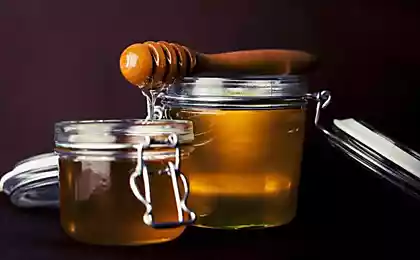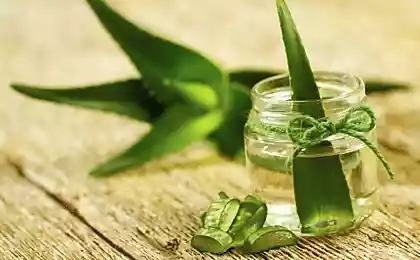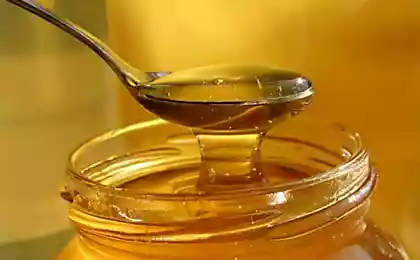627
Methods of treatment with honey
Conducted clinical observations and pilot experiments have shown that honey has strong antibacterial and anti-inflammatory properties. Honey is extremely effective in a painless cleansing of open wounds from infections and remove all of these damaged areas of the dead cells and also promotes the rapid development of new fabrics on the painful areas.

Mention the use of honey as a medicine preserved in Chronicles since the very ancient times. Today, however, scientists and physicians have re-discovered a strength of the therapeutic effect of honey on open wounds and damaged skin.
Professor of biochemistry at the University of Waikato (New Zealand), Dr. Peter Molan, who has been studying honey for 20 years, talks about the antimicrobial properties of honey as a highly experienced specialist: "Research conducted in many clinics, showed that honey is much more effective non-proliferation controls infection in patients with open burns than silver sulphate, which is also used as an antibacterial cream. In addition, honey stimulates the growth of new healthy tissue."(“Honey Against Infected Skin Lesions”).
Honey stimulates blood circulation and production of blood:
Med supplies most of the energy required by the body for blood production, it helps to cleanse the blood. Moreover, honey has a positive effect on blood circulation, being also a powerful natural preventative measure against atherosclerosis.
Honey is a natural antiseptic:
The antiseptic properties of honey prevent the formation and multiplication of bacteria, yeast and mold. Despite the fact that the bactericidal activity of honey remains poorly understood, many scientific studies have established the high antibacterial activity of honey against E. coli, Micrococcus, Staphylococcus and other microorganisms.The quality of honey and to prevent the existence of bacteria referred to as "ingibirovat impact" (the name of the inhibin a enzyme contained in the honey). There are several reasons providing a high antiseptic properties of honey. One of them is the high content in honey of sugar, which severely limits the amount of water in the honey-it is water, moisture is a necessary environment for the development of microorganisms and high acid content (low pH). In addition, honey does not contain nitrogen, and in besttoy environment the bacteria can not develop. Moreover, the honey contains hydrogen peroxide and antioxidants, which also prevent the growth of bacteria.
Honey is a powerful antioxidant:
Anyone who wants to lead a healthy lifestyle and permanently preserve youthfulness of the body, special attention should be paid to intake of antioxidants. Antioxidants are unique natural compounds that cleanse the cell from harmful side residues arising in the process of metabolism. The antioxidants slow down the destructive chemical and oxidative reactions that occur in cells as a result of unprocessed residues of metabolic waste products that lead to destruction of cell bonds and are the cause of aging and many chronic diseases. Doctors claim that foods rich in antioxidants can prevent the development of cancer and heart disease. Honey also contains powerful antioxidants: pinocembrin, pinobaxin, chrisin and galagin. Pinocembrin is a unique natural antioxidant which contains only honey and not found anywhere else.
Honey is full of vitamins and minerals:
Along with sugars such as fructose and glucose, honey contains many beneficial minerals: magnesium, potassium, calcium, chloride, sodium, sulfur, iron and phosphorus. Depending on the quality characteristics of nectar and pollen, it contains vitamins B 1, B 2, C, B 6, B 5 and B 3, and a bit of copper, iodine and zinc.
Used for healing wounds:
– Honey is used for wound healing, it prevents the appearance of scars at the wound site, as has the property to attract moisture from the air, thus accelerating the healing process of the skin. The fact that honey accelerates the growth of skin cells that form new skin growing into the wound. Thus, if you use honey to heal even large wounds do not require transplantation of skin tissue.
Honey stimulates the growth of new tissue involved in the healing process. It accelerates the formation of new capillary blood vessels, stimulates the growth of fibroblasts located in deeper layer of the skin, connective tissue, and accelerates the production of collagen fibers necessary for quick, complete healing.
– Honey also possesses anti-tumor effects, reducing swelling around the wounds. Honey increases blood circulation thus accelerates the healing process and reduces pain.
–Honey does not stick to the painful tissues in and around the wound. Therefore, during the ligation it can not damage newly formed tissue or cause pain.
–Honey is successfully used in the treatment of wounds that occur on the body cancer patients undergoing radiotherapy and in the treatment of stomach ulcers.
– Besides, thanks to the antiseptic, antimicrobial properties of honey, which we have discussed above, it prevents infection and existing infections quickly cleans and removes from the wound. Honey is very effective even against the ability of bacteria to resist antibiotics. Unlike medical, chemical antiseptics and antibiotics, honey never has a negative impact on the tissue of the wound.109
As follows from the above, honey is a unique product with a powerful medicinal properties, the gift of "healing." Revelation of verses of the Qur'an, without a doubt, are some of the Divine miracles of this Book, passed down to us by our Creator, the Possessor of Infinite Wisdom and Power.
10-13 September 2000, in Australia, in Melbourne, was held “the First world Congress of methodology of heal wounds”, which many doctors talked about the use of honey as a treatment for infectious wounds. The conclusions reached by the participants of the Congress, was given in the Bulletin of meetings:
"Many antibacterial agents used along with antibiotics in the treatment of open wounds, which became a gateway for infection, begin to resist antibiotics, it becomes a serious medical problem. At the same time, many natural substances are not effective in the treatment of wounds. However, honey is absolutely a great product for 4 thousand years it has been successfully used in the treatment of damaged and injured tissues. Honey has very active antibacterial agents; therefore, it is extremely efficient in cleansing wounds and protect them from infections and harmful bacteria."
Pharmacological properties of honey
Honey is a natural product, beneficial to health. It is used at any age. Part of the honey is easily digested by the body.
Honey is quickly absorbed into the bloodstream and muscle tissue and better than sugar, restores vitality. Especially helpful for people who are those who are recovering after an illness and restores ability to work.
Pharmacological properties of honey are manifold:
— anti-allergic;
— antibiotic (inhibits the activity of microbes, fungi, protozoa);
— antitoxic (promotes the excretion of toxins from the body, reduces side effects of medications, improves resistance to various poisons);
— have a positive influence on the intestinal microflora (regulates the secretion of the intestine in a concentration of up to 12.5% stimulates her to higher reduces, stimulates the processes of digestion and assimilation of nutrients);
— reducing (increases mental and physical performance, helps the body recover fatigue);
— immunological (increases the body's resistance to disease);
painkillers;
— tonic (has a beneficial effect on heart function, liver, kidney, stomach, intestine, cardiovascular, nervous and other systems and organs of the body, promotes longevity);
— expectorant and antitussive;
— anti-inflammatory;
— anticancer;
— radiation (increases resistance to adverse environmental factors, including penetrating radiation);
— wound healing;
— regulating metabolism;
— tonic;
— improves memory and eyesight, skin condition;
— soothing.
Honey stimulates the cardiovascular muscles, promotes expansion of venous vessels and improves blood circulation through this. In diseases of the liver and stomach honey relieves pain, nausea, heartburn. The systematic use of honey normalizes the gastrointestinal tract, beneficial during pregnancy.
Honey is recommended for the following diseases:
— anemia;
— asthenia, neurasthenia, depression, insomnia;
— vegetative neurosis;
— inflammation of eyes (conjunctivitis, keratitis, herpetic lesions of the cornea and it burns);
— hair loss;
— gastritis;
— gynecological diseases (cervical erosion, inflammation of uterus, inflammation of the vagina, etc.);
headaches;
— dermatitis;
— dystrophy of myocardium;
— diseases of the liver and biliary tract;
— constipation;
— impotence;
— coronary heart disease;
— metabolic disorders;
— urinary incontinence;
— the need to stimulate processes of tissue regeneration in the body;
— acute and chronic diseases of the upper respiratory tract and lungs;
— fractures, wounds, burns, frostbite, boils;
— overwork and high stress in athletes;
— preparation for surgery;
— premature aging;
— radiation exposure;
— reduced vision;
— decrease in immunity;
— loss of memory;
— physical and mental fatigue;
— chronic intoxication;
— chronic kidney disease;
— enteritis and colitis;
— peptic ulcer of stomach and duodenum.
For each disease, choose the appropriate type of honey. For example, in diseases of the Airways and lungs recommended mountain honey, honey with oregano, thyme, Linden; in diseases of the digestive system — steppe, mint, buckwheat, thyme; in diseases of the heart with lavender, mint, lemon balm. The best honey at nephritic diseases — brown, with wild herbs, fruit and berry crops.
The most effective on the pathogens of various diseases of the honey collected from chestnut, Linden, clover, Apple, pear. This is due to the activity of phytoncides, which are formed in plants.
A daily dose of honey as a food and a dietary substance for an adult is 60-100 g, divided into several receptions. So honey is better absorbed, it should take 1.5-2 hours before eating or 3 hours after a meal. The most useful application of honey with warm boiled water, tea or milk. Honey is good mixed with juices, fruits and vegetables, and dairy products, jellies, compotes, cereals.
For therapeutic purposes, honey is more rational to take in dissolved form. For the adult daily dose is 100-200 g. This dose is distributed into three portions: in the morning take 30-60 grams a day — 40-60 g and evening — 30-60 g (1,5-2 hours before or 3 hours after eating). The course of treatment — 2 months.
Give children honey 1 teaspoon (approximately 30 g) per day.
Methods of treatment with honey
Ingestion —daily, 1-2 g per kilogram of weight:
in diseases of the upper respiratory tract it is recommended that honey kept in the mouth 6 times per day;
in diseases of the gastrointestinal tract, renal diseases and neurosis prescribe of honey, diluted with warm water, 3 times a day for 10-20 minutes before meals or 2-3 hours after a meal.
Inhalation — use 5-10% solution of honey in distilled water (home — boiled) or in physiological solution (0.9% NaCl solution).
Inhalation is carried out for 5-10 minutes 1-2 times a day for sore throat, sinusitis and other respiratory diseases.
Local application is effective in diseases of the pharynx (pharyngitis, tonsillitis, and laryngitis), as well as for inflammation of the female genital organs (colpitis), poorly healing and chronic wounds.
Rinsing and washing of the 30% honey solution are assigned with stomatitis, pharyngitis, laryngitis, vaginitis (2-4 treatments per day to cure).
The introduction of honey with the help of ultrasound and current (Phono electropores) is 20-30% solution of honey. Indicated for rhinitis, sinusitis, bronchitis, vaginitis, parametritis, adnexitis, trichomoniasis.
Procedure is prescribed 1 times a day, its duration of 10-15 min (the strength of the current during electrophoresis of 5-20 mA).
In the treatment of burns, purulent and long-healing wounds and trophic ulcers effective contains honey ointment:
You need to know that honey should not take patients who need to limit their carbs and who have observed allergic diathesis to honey. Not often, but there are people who can't use honey (orally or topically — spray, and local application) because of the special sensitivity to it (idiosyncrasy). From honey-they have hives, itching, runny nose, headaches, respiratory and gastrointestinal disorders. A med is contraindicated. In practice, hypersensitivity to honey is very rare.
Predisposed to diabetes patients honey can be recommended in small amounts, when no other concentrated sweets, and mainly mixed with pollen, under the supervision of a physician.
There is a misconception that honey should not be taken with scrofula. Observations show that, on the contrary, the inclusion of honey in the diet of children suffering from scrofula, promotes more rapid recovery. We should not only give honey to children with hypersensitivity to it.
The same can be said about children with exudative diathesis. Honey is not contraindicated, if there is no idiosyncrasy.
To determine the sensitivity to honey child you need to give first a small amount (0.5 teaspoon). If not strengthen diathesis, rash more rash or other manifestations of idiosyncrasy, you can give 1 teaspoon of honey a day. Honey will only contribute to recovery. It is better to give together with other types of food, such as porridge, fruit or tea. In this form, the honey is better absorbed.
Aerosol treatment with honey can not be administered to patients suffering from a pronounced emphysema (dilation of the alveoli), during an attack of asthma and asthmatic condition, stradasim myocarditis, damaged heart valves, in the temperature condition in sclerosis of the lungs, cardiac asthma, frequent bleeding from the respiratory tract.published
P. S. And remember, only by changing their consumption — together we change the world! ©
Source: islambio.com/pitanie/med_metody_lecheniya_medom.htm#more-652

Mention the use of honey as a medicine preserved in Chronicles since the very ancient times. Today, however, scientists and physicians have re-discovered a strength of the therapeutic effect of honey on open wounds and damaged skin.
Professor of biochemistry at the University of Waikato (New Zealand), Dr. Peter Molan, who has been studying honey for 20 years, talks about the antimicrobial properties of honey as a highly experienced specialist: "Research conducted in many clinics, showed that honey is much more effective non-proliferation controls infection in patients with open burns than silver sulphate, which is also used as an antibacterial cream. In addition, honey stimulates the growth of new healthy tissue."(“Honey Against Infected Skin Lesions”).
Honey stimulates blood circulation and production of blood:
Med supplies most of the energy required by the body for blood production, it helps to cleanse the blood. Moreover, honey has a positive effect on blood circulation, being also a powerful natural preventative measure against atherosclerosis.
Honey is a natural antiseptic:
The antiseptic properties of honey prevent the formation and multiplication of bacteria, yeast and mold. Despite the fact that the bactericidal activity of honey remains poorly understood, many scientific studies have established the high antibacterial activity of honey against E. coli, Micrococcus, Staphylococcus and other microorganisms.The quality of honey and to prevent the existence of bacteria referred to as "ingibirovat impact" (the name of the inhibin a enzyme contained in the honey). There are several reasons providing a high antiseptic properties of honey. One of them is the high content in honey of sugar, which severely limits the amount of water in the honey-it is water, moisture is a necessary environment for the development of microorganisms and high acid content (low pH). In addition, honey does not contain nitrogen, and in besttoy environment the bacteria can not develop. Moreover, the honey contains hydrogen peroxide and antioxidants, which also prevent the growth of bacteria.
Honey is a powerful antioxidant:
Anyone who wants to lead a healthy lifestyle and permanently preserve youthfulness of the body, special attention should be paid to intake of antioxidants. Antioxidants are unique natural compounds that cleanse the cell from harmful side residues arising in the process of metabolism. The antioxidants slow down the destructive chemical and oxidative reactions that occur in cells as a result of unprocessed residues of metabolic waste products that lead to destruction of cell bonds and are the cause of aging and many chronic diseases. Doctors claim that foods rich in antioxidants can prevent the development of cancer and heart disease. Honey also contains powerful antioxidants: pinocembrin, pinobaxin, chrisin and galagin. Pinocembrin is a unique natural antioxidant which contains only honey and not found anywhere else.
Honey is full of vitamins and minerals:
Along with sugars such as fructose and glucose, honey contains many beneficial minerals: magnesium, potassium, calcium, chloride, sodium, sulfur, iron and phosphorus. Depending on the quality characteristics of nectar and pollen, it contains vitamins B 1, B 2, C, B 6, B 5 and B 3, and a bit of copper, iodine and zinc.
Used for healing wounds:
– Honey is used for wound healing, it prevents the appearance of scars at the wound site, as has the property to attract moisture from the air, thus accelerating the healing process of the skin. The fact that honey accelerates the growth of skin cells that form new skin growing into the wound. Thus, if you use honey to heal even large wounds do not require transplantation of skin tissue.
Honey stimulates the growth of new tissue involved in the healing process. It accelerates the formation of new capillary blood vessels, stimulates the growth of fibroblasts located in deeper layer of the skin, connective tissue, and accelerates the production of collagen fibers necessary for quick, complete healing.
– Honey also possesses anti-tumor effects, reducing swelling around the wounds. Honey increases blood circulation thus accelerates the healing process and reduces pain.
–Honey does not stick to the painful tissues in and around the wound. Therefore, during the ligation it can not damage newly formed tissue or cause pain.
–Honey is successfully used in the treatment of wounds that occur on the body cancer patients undergoing radiotherapy and in the treatment of stomach ulcers.
– Besides, thanks to the antiseptic, antimicrobial properties of honey, which we have discussed above, it prevents infection and existing infections quickly cleans and removes from the wound. Honey is very effective even against the ability of bacteria to resist antibiotics. Unlike medical, chemical antiseptics and antibiotics, honey never has a negative impact on the tissue of the wound.109
As follows from the above, honey is a unique product with a powerful medicinal properties, the gift of "healing." Revelation of verses of the Qur'an, without a doubt, are some of the Divine miracles of this Book, passed down to us by our Creator, the Possessor of Infinite Wisdom and Power.
10-13 September 2000, in Australia, in Melbourne, was held “the First world Congress of methodology of heal wounds”, which many doctors talked about the use of honey as a treatment for infectious wounds. The conclusions reached by the participants of the Congress, was given in the Bulletin of meetings:
"Many antibacterial agents used along with antibiotics in the treatment of open wounds, which became a gateway for infection, begin to resist antibiotics, it becomes a serious medical problem. At the same time, many natural substances are not effective in the treatment of wounds. However, honey is absolutely a great product for 4 thousand years it has been successfully used in the treatment of damaged and injured tissues. Honey has very active antibacterial agents; therefore, it is extremely efficient in cleansing wounds and protect them from infections and harmful bacteria."
Pharmacological properties of honey
Honey is a natural product, beneficial to health. It is used at any age. Part of the honey is easily digested by the body.
Honey is quickly absorbed into the bloodstream and muscle tissue and better than sugar, restores vitality. Especially helpful for people who are those who are recovering after an illness and restores ability to work.
Pharmacological properties of honey are manifold:
— anti-allergic;
— antibiotic (inhibits the activity of microbes, fungi, protozoa);
— antitoxic (promotes the excretion of toxins from the body, reduces side effects of medications, improves resistance to various poisons);
— have a positive influence on the intestinal microflora (regulates the secretion of the intestine in a concentration of up to 12.5% stimulates her to higher reduces, stimulates the processes of digestion and assimilation of nutrients);
— reducing (increases mental and physical performance, helps the body recover fatigue);
— immunological (increases the body's resistance to disease);
painkillers;
— tonic (has a beneficial effect on heart function, liver, kidney, stomach, intestine, cardiovascular, nervous and other systems and organs of the body, promotes longevity);
— expectorant and antitussive;
— anti-inflammatory;
— anticancer;
— radiation (increases resistance to adverse environmental factors, including penetrating radiation);
— wound healing;
— regulating metabolism;
— tonic;
— improves memory and eyesight, skin condition;
— soothing.
Honey stimulates the cardiovascular muscles, promotes expansion of venous vessels and improves blood circulation through this. In diseases of the liver and stomach honey relieves pain, nausea, heartburn. The systematic use of honey normalizes the gastrointestinal tract, beneficial during pregnancy.
Honey is recommended for the following diseases:
— anemia;
— asthenia, neurasthenia, depression, insomnia;
— vegetative neurosis;
— inflammation of eyes (conjunctivitis, keratitis, herpetic lesions of the cornea and it burns);
— hair loss;
— gastritis;
— gynecological diseases (cervical erosion, inflammation of uterus, inflammation of the vagina, etc.);
headaches;
— dermatitis;
— dystrophy of myocardium;
— diseases of the liver and biliary tract;
— constipation;
— impotence;
— coronary heart disease;
— metabolic disorders;
— urinary incontinence;
— the need to stimulate processes of tissue regeneration in the body;
— acute and chronic diseases of the upper respiratory tract and lungs;
— fractures, wounds, burns, frostbite, boils;
— overwork and high stress in athletes;
— preparation for surgery;
— premature aging;
— radiation exposure;
— reduced vision;
— decrease in immunity;
— loss of memory;
— physical and mental fatigue;
— chronic intoxication;
— chronic kidney disease;
— enteritis and colitis;
— peptic ulcer of stomach and duodenum.
For each disease, choose the appropriate type of honey. For example, in diseases of the Airways and lungs recommended mountain honey, honey with oregano, thyme, Linden; in diseases of the digestive system — steppe, mint, buckwheat, thyme; in diseases of the heart with lavender, mint, lemon balm. The best honey at nephritic diseases — brown, with wild herbs, fruit and berry crops.
The most effective on the pathogens of various diseases of the honey collected from chestnut, Linden, clover, Apple, pear. This is due to the activity of phytoncides, which are formed in plants.
A daily dose of honey as a food and a dietary substance for an adult is 60-100 g, divided into several receptions. So honey is better absorbed, it should take 1.5-2 hours before eating or 3 hours after a meal. The most useful application of honey with warm boiled water, tea or milk. Honey is good mixed with juices, fruits and vegetables, and dairy products, jellies, compotes, cereals.
For therapeutic purposes, honey is more rational to take in dissolved form. For the adult daily dose is 100-200 g. This dose is distributed into three portions: in the morning take 30-60 grams a day — 40-60 g and evening — 30-60 g (1,5-2 hours before or 3 hours after eating). The course of treatment — 2 months.
Give children honey 1 teaspoon (approximately 30 g) per day.
Methods of treatment with honey
Ingestion —daily, 1-2 g per kilogram of weight:
in diseases of the upper respiratory tract it is recommended that honey kept in the mouth 6 times per day;
in diseases of the gastrointestinal tract, renal diseases and neurosis prescribe of honey, diluted with warm water, 3 times a day for 10-20 minutes before meals or 2-3 hours after a meal.
Inhalation — use 5-10% solution of honey in distilled water (home — boiled) or in physiological solution (0.9% NaCl solution).
Inhalation is carried out for 5-10 minutes 1-2 times a day for sore throat, sinusitis and other respiratory diseases.
Local application is effective in diseases of the pharynx (pharyngitis, tonsillitis, and laryngitis), as well as for inflammation of the female genital organs (colpitis), poorly healing and chronic wounds.
Rinsing and washing of the 30% honey solution are assigned with stomatitis, pharyngitis, laryngitis, vaginitis (2-4 treatments per day to cure).
The introduction of honey with the help of ultrasound and current (Phono electropores) is 20-30% solution of honey. Indicated for rhinitis, sinusitis, bronchitis, vaginitis, parametritis, adnexitis, trichomoniasis.
Procedure is prescribed 1 times a day, its duration of 10-15 min (the strength of the current during electrophoresis of 5-20 mA).
In the treatment of burns, purulent and long-healing wounds and trophic ulcers effective contains honey ointment:
- ointment Kon'kova main (ethacridine lactate 0.3 g, distilled water up to 100 g cod fish oil 34.5 g, med 64 g);
- ointment Kon'kova with the fly in the ointment (ethacridine lactate 0.3 g, distilled water 1.5 g fish oil, 35 g of honey 62 g, birch tar 3 g);
- ointment Kon'kova with Ichthyol (Ichthyol 5 g, anhydrous lanolin 3 g, ointment Kon'kova main 100 g);
- ointment Kon'kova with syntomycin (syntomycin 3-5 g, ointment Kon'kova main 100 g).
You need to know that honey should not take patients who need to limit their carbs and who have observed allergic diathesis to honey. Not often, but there are people who can't use honey (orally or topically — spray, and local application) because of the special sensitivity to it (idiosyncrasy). From honey-they have hives, itching, runny nose, headaches, respiratory and gastrointestinal disorders. A med is contraindicated. In practice, hypersensitivity to honey is very rare.
Predisposed to diabetes patients honey can be recommended in small amounts, when no other concentrated sweets, and mainly mixed with pollen, under the supervision of a physician.
There is a misconception that honey should not be taken with scrofula. Observations show that, on the contrary, the inclusion of honey in the diet of children suffering from scrofula, promotes more rapid recovery. We should not only give honey to children with hypersensitivity to it.
The same can be said about children with exudative diathesis. Honey is not contraindicated, if there is no idiosyncrasy.
To determine the sensitivity to honey child you need to give first a small amount (0.5 teaspoon). If not strengthen diathesis, rash more rash or other manifestations of idiosyncrasy, you can give 1 teaspoon of honey a day. Honey will only contribute to recovery. It is better to give together with other types of food, such as porridge, fruit or tea. In this form, the honey is better absorbed.
Aerosol treatment with honey can not be administered to patients suffering from a pronounced emphysema (dilation of the alveoli), during an attack of asthma and asthmatic condition, stradasim myocarditis, damaged heart valves, in the temperature condition in sclerosis of the lungs, cardiac asthma, frequent bleeding from the respiratory tract.published
P. S. And remember, only by changing their consumption — together we change the world! ©
Source: islambio.com/pitanie/med_metody_lecheniya_medom.htm#more-652























